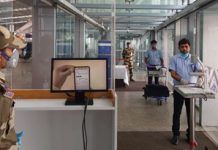The use of biometric facial recognition for large-scale surveillance and crime prevention has become widespread. According to the Panoptic Tracker by the Internet Freedom Foundation (IFF), there are 170 facial recognition systems in India, but only a few of them are operational.
Among the 170 systems, only 20 facial recognition systems are operational in locations such as Telangana, Delhi, and Maharashtra. The majority of the systems, more than 85 percent, are in various stages of tender bidding, implementation, procurement, and finalisation.
According to the IFF report, the central and state governments have collectively spent around 15.13 billion Indian rupees (approximately US$181 million) on these systems, with ₹7.7 billion ($92.2 million) from the central government and ₹7.43 billion ($88.94 million) from the state governments.
“The unavailability of uniform information across states varies significantly, which leads to certain states showing more FRTs and, subsequently, ranking higher in related metrics,” says Anushka Jain, who formerly worked as a Policy Council at the IFF and developed the Panoptic Tracker, says.
Delhi has the second most active facial recognition systems deployed in place. An independent researcher, Srinivas Kodali, said, “For instance, after the Nirbhaya case in Delhi post-2012, there was a significant push for installing CCTV cameras.” He further added, “The AAP (Aam Aadmi Party) advocated for CCTVs in Delhi to monitor the police and enhance public safety.”
Around 12.4 percent of facial recognition systems are utilised in the transport industry. Indian Railways has recently taken steps to enhance the safety of its train stations in the Eastern region by implementing Herta Security’s facial recognition. In other news, the Indian Railways has contracted NtechLab to deploy its facial recognition systems at 30 stations.
It is observed that defence organisations, such as the police and army, make more use of facial recognition systems than any other industry, accounting for a 20 percent share, as per the IFF report. Other industries that use facial recognition include education, energy, and public infrastructure, among others.
To capitalise on this growing use of face recognition in India, RecFaces is aiming for a strategic trip to the country which will include face-to-face meetings, inviting distributors, partners, and end users, across Mumbai, Bangalore, Hyderabad, and Delhi.
“India’s burgeoning market for facial recognition technology presents significant opportunities. We are committed to delivering personalised support and showcasing how our solutions can enhance security and operational efficiency across various sectors,” says Sukrit Varma, global marketing partner for APAC and MENA region at RecFaces.








